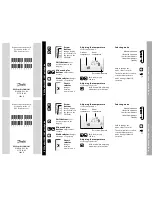
Chapter 12 PACTOR Operation
If the changeover time from transmit to receive in your radio set-up is too long, the ack signal from the distant
station will arrive before your radio has switched back to receive. However, if the transmitting station is further
away, the transmission time over the propagation path will delay the arrival of the signal until after your radio has
switched to receive. For this reason, you may be able to link with stations across the world easier than across town.
If switching-time problems persist, you may have to make changes in the radio to eliminate excessive time delays:
♦
Remove large decoupling capacitors from the Push-To-Talk line to allow faster PTT (transmitter)
activation;
♦
Improve power supply decoupling, especially in audio stages.
♦
Don
’t use the squelch control.
Another solution is for either you or the other station to change the timing value in
ADELAY
.
In case you can’t solve your radio’s switching-time problems, call AEA for assistance.
Control Key Summary:
CTRL+B
Sends
your
AAB
message.
CTRL+C
Takes you out of the Converse mode and into the Command mode.
CTRL+D
Stops your radio from transmitting when the transmit buffer is empty.
CTRL+E
Sends a “Who Are You” (WRU?) request to the other station. This causes the other station to send
its callsign. (...and serial number of the PACTOR chips if it’s a DSP232MBX.)
CTRL+F
Unkeys the transmitter after the transmit buffer is empty, sends your callsign in Morse, then returns
the DSP to PACTOR Standby in the Command mode.
CTRL+T
Sends the time if
DAYTIME
and (or) date if
DAYSTAMP
is
ON
.
CTRL+Z
Changes your DSP from send (ISS) to receive (IRS).
Action
Keystroke
On-Screen Text
Front Panel LEDs
Enter PACTOR mode
PT
Opmode was (previous mode)
Opmode now PACTOr
Pactor
Monitor PACTOR traffic
while unconnected
PTL
Opmode was (previous mode)
Opmode now PTList
Phase
Put DSP in unproto mode
Send CQ or a message
PTS
CQ CQ CQ,
DE (yourcall
3X)...
(CTRL+D)
Opmode was (previous mode)
Opmode now PTSend
(enter your CQ text or send a message
while not connected, then follow it by a
CTRL+D
.)
cmd:
TX+Idle/FEC
Another station answers
your CQ and connects to
you
*** CONNECTED to (callsign)
CONnected/ARQ
Idle/ARQ
The other station sends
text...
(text)
Traffic/ARQ
Idle/ARQ
...then he turns it over to
you when it’s your turn
K, BTU, > (your choice)
TX+Idle/ARQ
You send text back to him
(text)
(text) TX+Traffic/ARQ
...then you flip it over to
him
K, BTU, > ...
(CTRL+Z)
Over/ARQ
Idle/ARQ
You end the QSO (while
it’s your turn to transmit)
(CTRL+D)
*** DISCONNECTED: (callsign)
TX+Over/ARQ
September, 05
12-7
Summary of Contents for DSP-232
Page 120: ...Chapter 6 GPS Applications September 05 6 1...
Page 138: ...Chapter 7 Maildrop Operation 7 18 September 05...
Page 158: ......
Page 159: ...Chapter 8 ASCII and Baudot Operation September 05 8 1...
Page 185: ......
Page 186: ...Chapter 9 AMTOR Operation September 05 9 1...
Page 198: ......
Page 199: ...Chapter 10 Morse Operation September 05 10 1...
Page 207: ......
Page 208: ...Chapter 11 SIAM and NAVTEX Operation September 05 11 1...
Page 230: ......
Page 231: ...Chapter 12 PACTOR Operation September 05 12 1...
Page 240: ...Chapter 13 Troubleshooting September 05 13 9...
Page 254: ...Chapter 13 Troubleshooting 13 9...
Page 256: ...DSP 232 Manual Addendum September 05 AD 2...
Page 259: ...Appendix A Radio Connections Radio Connection Diagrams September 05 A 3...
Page 260: ...Appendix A Radio Connections A 4 September 05...
Page 261: ...Appendix A Radio Connections September 05 A 5...
Page 262: ...Appendix A Radio Connections A 6 September 05...
Page 263: ...Appendix A Radio Connections September 05 A 7...
Page 267: ...Appendix D Mailbox Upgrade September 05 D 2...
Page 268: ...Appendix E Schematics and Pictorial September 05 E 3...
















































